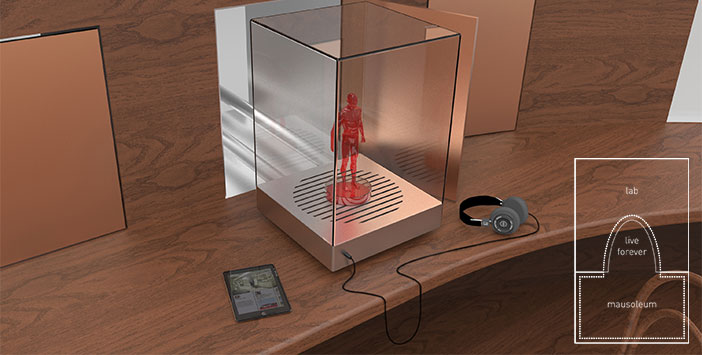Live Forever 细胞永生法
Designs On— Aging
In 1951, a woman from rural Maryland named Henrietta Lacks checked into a hospital at Johns Hopkins with symptoms diagnosed as cervical cancer. Doctors attempted to treat her, and without her consent took tissue samples of her tumor. The cancer cells taken from Henrietta possessed an unusual property. They could grow and divide —live— outside her body indefinitely. Henrietta died in 1951, but her cells, now named HeLa, lived on. In 1954 they were used by Jonas Salk to develop the first polio vaccine, and have been used since in research on cancer, AIDS, and many other diseases.
Live Forever is a way for scientists to immortalize tissue samples on demand. We imagine a space that explicitly acknowledges the complex relationship between the sanctity of a loved one and scientific contribution embodied in these immortal cell-lines. In a visiting room adjacent to the lab’s clean room, a custom 3D printed vessel holds a loved one’s genomic and cellular traces. In addition, relatives can control research permissions, while scientists can share their learnings from the cells via recorded oral stories and digital posts.
1951年,一位来自马里兰州乡村的名为Henrietta Lacks的妇女被诊断为宫颈癌,住进了约翰霍普金斯医院。医生们在治疗过程中,
在未获得她允许的情况下对她的肿瘤进行了取样。她的癌细胞呈现出特殊的属性:可以独立于体外,无限地生长、分化。1951年Henrietta去世,但是她名为HeLa的细胞却存活了下来。1954年,Jonas Salk用其研制出了第一个小儿麻痹症疫苗,自此之后一直被用于癌症、艾滋病和其他疾病的研究。
“细胞永生法”可以帮助科学家们将人体组织样本做永久保存。在这样一个空间中,我们完全承认并尊重您最爱的人身体的神圣性及其不朽的细胞系所具有的科学价值。在实验室的无尘室旁边设有访客间,里面有一台定做的3D打印试管,里面装有最爱的人的染色体和细胞株。研究许可权完全掌握在亲人手中,科学家可以通过录音和数字记录与家人分享研究成果。
